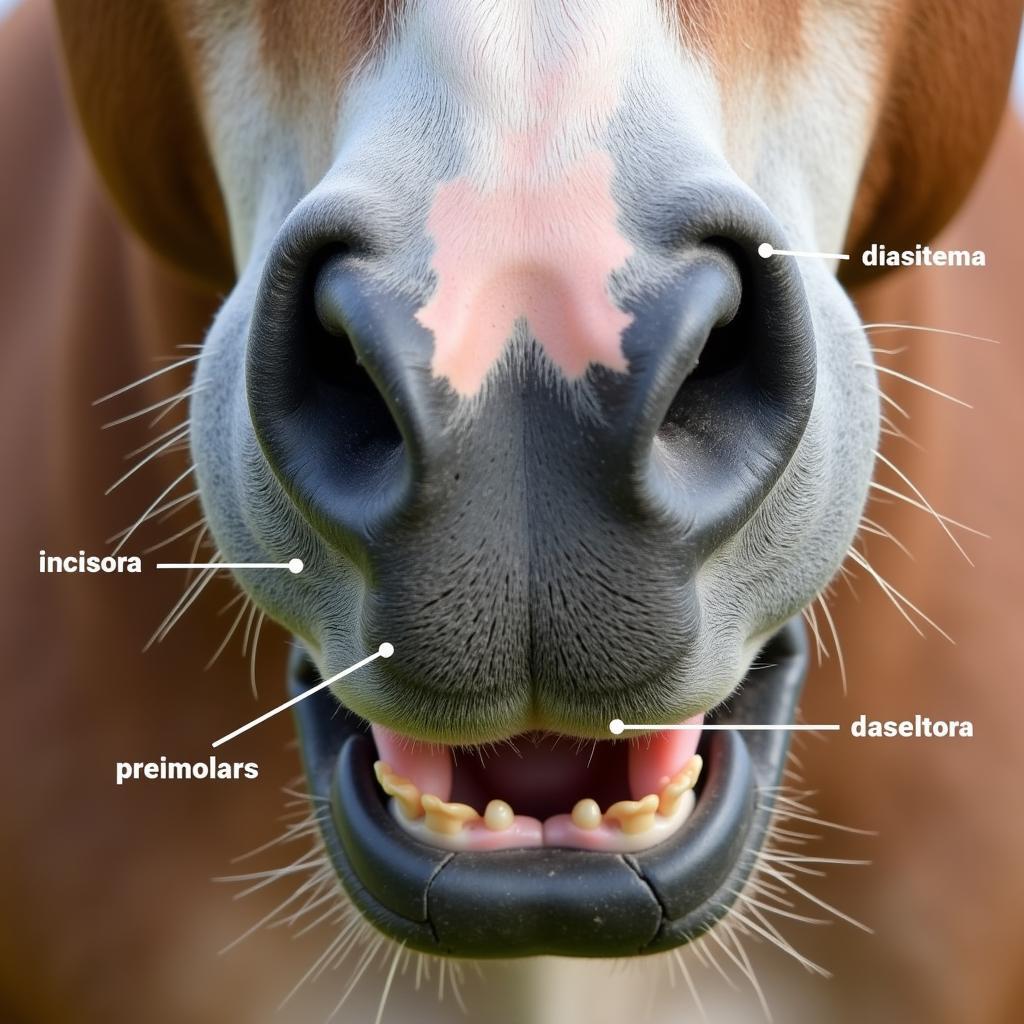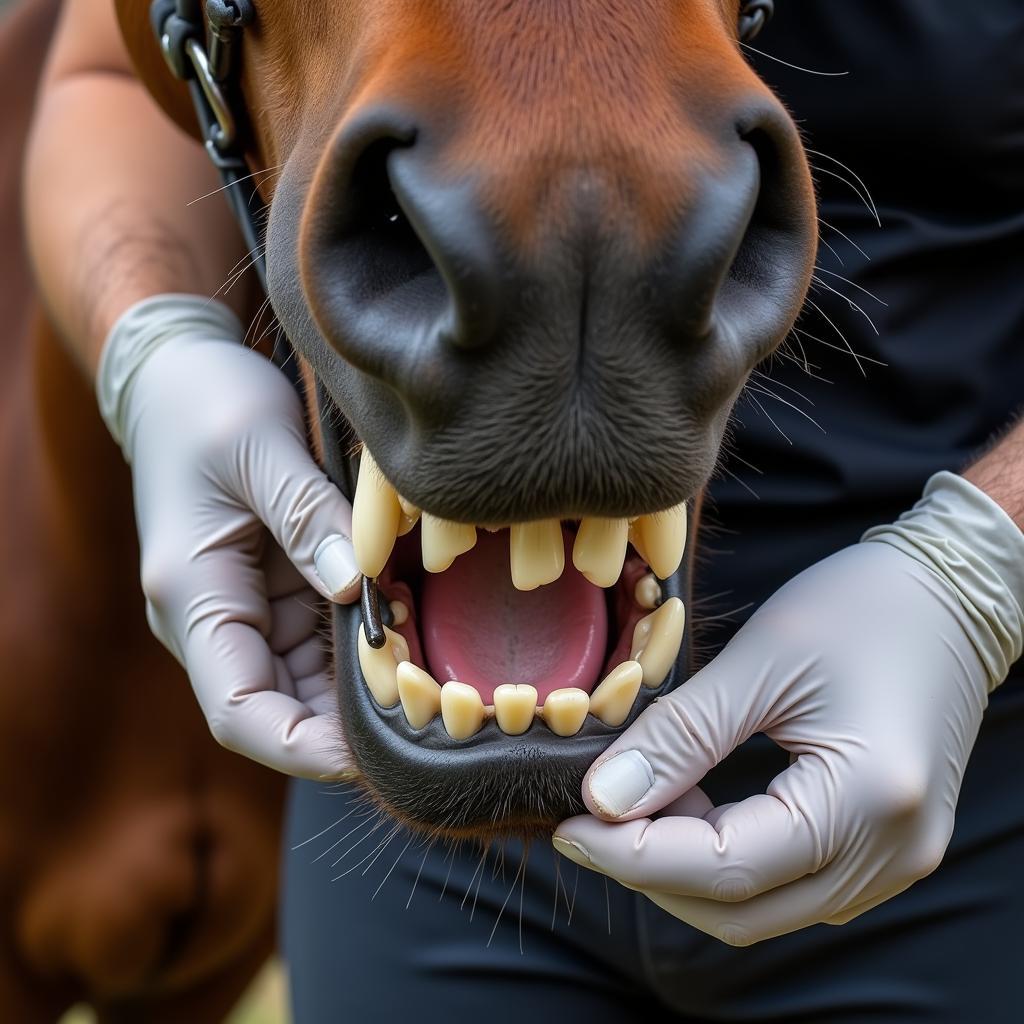Diastema In Horses refers to the naturally occurring gap or space between the incisors (front teeth) and premolars (cheek teeth) in a horse’s mouth. This gap, often referred to as the “bars” of the horse’s mouth, is a normal anatomical feature present in most horses.
 Horse Diastema Anatomy
Horse Diastema Anatomy
The Purpose of Diastema in Horses
While it might seem unusual, the diastema serves important purposes in a horse’s daily life. Primarily, it provides a space for the bit to rest comfortably when a horse is bridled. The bit, an essential tool for communication and control between horse and rider, sits in this gap, allowing for clear signals and pressure points without interfering with the horse’s chewing or breathing.
Beyond riding, the diastema also aids horses in grazing. They use their sensitive lips and tongue to grasp and pull grass into their mouths. The gap allows them to efficiently bite off large amounts of forage without the interference of the bit.
Variations in Diastema Size
The size of the diastema can vary considerably between individual horses due to factors like breed, age, and genetics. Some horses may have a larger gap, while others have a smaller one. It’s important to note that the size of the diastema doesn’t necessarily indicate a horse’s health or riding ability.
“Just like humans, horses have unique dental structures,” explains Dr. Emily Carter, DVM, an equine dental specialist. “The size of the diastema is simply a variation within the normal range and shouldn’t be a cause for concern unless it’s causing problems with bitting or eating.”
 Horse Diastema Size Variations
Horse Diastema Size Variations
Potential Issues Related to Diastema
While a diastema is a normal part of a horse’s anatomy, certain issues can arise:
- Bitting Problems: An unusually small diastema might make it challenging to find a bit that fits comfortably, potentially causing pain or discomfort for the horse. Conversely, a very large diastema might allow the bit to move excessively, leading to ineffective communication and control.
- Wolf Teeth: In some cases, horses may develop small, pointed teeth known as wolf teeth in the diastema area. These teeth can interfere with the bit, causing pain and behavioral issues.
If you notice your horse displaying signs of discomfort while being ridden, such as head tossing, tongue lolling, or resistance to the bit, it’s crucial to consult with an equine veterinarian or a qualified equine dentist. They can examine your horse’s mouth, identify any potential problems related to the diastema, and recommend appropriate solutions, which might involve adjustments to the bit or extraction of wolf teeth.
 Equine Dental Exam
Equine Dental Exam
Caring for Your Horse’s Diastema
Proper dental care is essential for maintaining your horse’s overall health and well-being. Regular dental checkups, typically once or twice a year, by a veterinarian or equine dentist can help identify and address any issues early on. These checkups often involve:
- Floating: A procedure to file down any sharp points or hooks on the teeth, including those in the diastema area.
- Wolf Teeth Extraction: If wolf teeth are present and causing problems, they can be safely removed by a veterinarian.
In addition to professional care, providing your horse with a balanced diet and observing them for any signs of dental problems can contribute to their long-term oral health.
Conclusion
Diastema in horses is a natural and essential part of their anatomy. Understanding its purpose and the potential issues that can arise helps ensure that we provide our equine companions with the best possible care. Regular dental check-ups, proper bitting, and vigilant observation are crucial for maintaining their oral health and ensuring a comfortable riding experience. If you have any concerns about your horse’s diastema or overall dental health, don’t hesitate to contact your veterinarian or a qualified equine dentist.
FAQs
1. Does the size of a horse’s diastema affect its temperament?
No, the size of the diastema doesn’t influence a horse’s temperament or personality. Temperament is determined by a complex interplay of genetics, environment, and training.
2. Can a horse’s diastema change size over time?
While the diastema is primarily determined by genetics, it can appear to change slightly as a horse ages due to wear and tear on the teeth.
3. Is it painful for a horse to have its teeth floated?
Floating, when performed correctly by a trained professional, is generally not painful for horses.
4. How often should I have my horse’s wolf teeth checked?
If your horse has wolf teeth, it’s a good idea to have them checked during their annual dental exam.
5. What should I do if I think my horse’s bit isn’t fitting correctly?
If you suspect a bitting issue, stop riding and consult with an equine veterinarian or a qualified equine bitting specialist. They can help you determine the best course of action.
Need More Help?
For any concerns regarding your horse’s health or to schedule an appointment, please reach out to us:
Phone Number: 0772127271
Email: [email protected]
Address: QGM2+WX2, Vị Trung, Vị Thuỷ, Hậu Giang, Việt Nam.
Our dedicated team is available 24/7 to assist you.